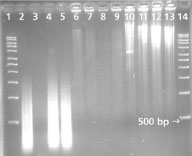Whole Genome Amplification: Blood Card Protocol
Blood cards provide the convenience of archiving small volumes of blood. However, many times genomic DNA from these samples is limited, which may hinder the researcher’s ability to perform downstream analysis. This protocol provides a simple and convenient method to extract genomic DNA from a blood card. Once the DNA has been extracted, it can then be amplified using the GenomePlex® Whole Genome Amplification protocol.
Required Products
- GenElute™ Blood Genomic DNA Kit (Product No. NA2000)
Materials to be supplied by the User
- Blood card
- 1.5 ml microcentrifuge tubes
- Ethanol (Product No. E7023)
- Microcentrifuge (with rotor for 2 ml tubes)
- Water, molecular biology reagent (Product No. W4502)
- 55 °C water bath or heat block
Extraction of DNA from a Blood Card
The GenElute Blood Genomic DNA Kit (Product No. NA2000) is recommended for this procedure.
- Cut a disc from a dried blood card (200 µL spotted) into several 2 mm by 2 mm pieces and place the pieces into a 1.5 ml microcentrifuge tube.
- Add 40 µL Proteinase K and 1.0 ml Resuspension Solution.
- Add 300 µL of Lysis Solution C and vortex thoroughly for 15 seconds.
- Incubate at 55 °C for 10 minutes.
- After the incubation, transfer the liquid (discard blood card remaining in the microcentrifuge tube) to a 15 ml conical tube.
- Add 500 µL of Column Preparation Solution to the GenElute Miniprep Binding Column (red o-ring) and centrifuge at 12,000 × g for 1 minute.
- Discard the flow-through liquid.
Note: The Column Preparation Solution maximizes binding of DNA to the membrane resulting in more consistent yields. - Add 900 µL of 95–100% ethanol to the lysate in the 15 ml conical tube and mix thoroughly by vortexing 5–10 seconds.
- Transfer the contents of the tube into the treated column from step 6. Centrifuge at ≥6500 × g for 1 minute. Repeat until all of the lysate has been passed through the column.
- Discard the collection tube and flow-through. Place the column in a new 2 ml collection tube.
- Add 500 µL of Prewash Solution (be sure to dilute with ethanol prior to first use) and centrifuge for 1 minute at ≥6,500 × g.
- Discard the collection tube containing the flow-through and place the binding column into a new 2 ml collection tube.
- Add 500 µL of Wash Solution (be sure to dilute with ethanol prior to first use) to the binding column and centrifuge at maximum speed (12,000–16,000 × g) for 3 minutes to dry the binding column.
- Pipette 400 µL of Elution Solution onto the column and centrifuge for 1 minute at ≥6500 × g to elute the DNA.
- Store the eluted DNA at –20 °C or proceed to the amplification step.
Amplified Human Genomic DNA from Blood Card

Legend: Products were amplified using the GenomePlex Whole Genome Amplification Kit (Product No. WGA1) from Sigma, Supplier A’s kit and Supplier Q’s kit. Products were resolved on a 1.5% agarose gel. 5 µL of amplified product was added to each well. The products amplified using GenomePlex technology were of a smaller molecular weight as shown on the gel when compared to Supplier A and Q. This is due to the random fragmentation of genomic DNA prior to amplification. Sigma’s amplified products are specific and there is no amplicon visible in the negative control (lane 2) indicating that only the desired genomic DNA is amplified. Both Suppliers A and Q yield a nonspecific signal in the negative control which is equal in size and intensity to the signal for the suppliers’ positive control. |
|
Lane 1—1 kb Marker |
Lane 8—Supplier A Blood Card |
To continue reading please sign in or create an account.
Don't Have An Account?